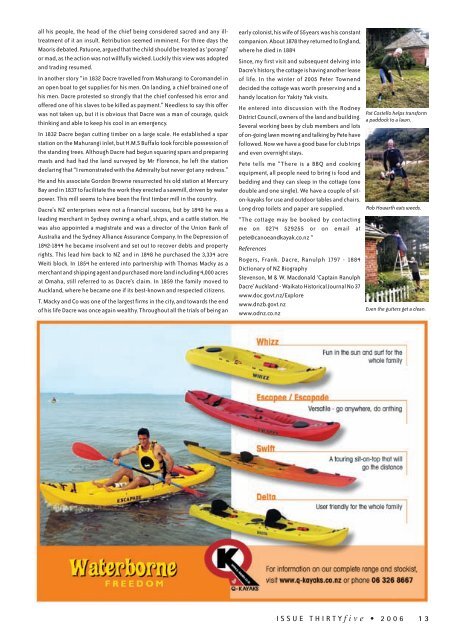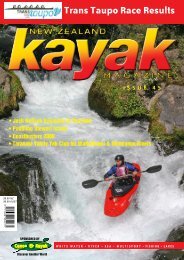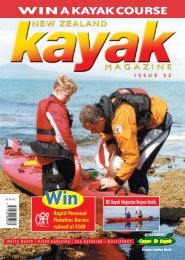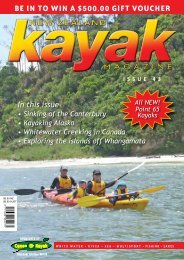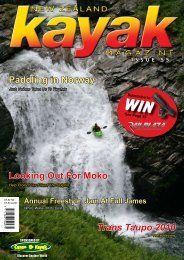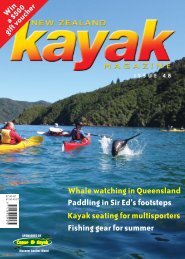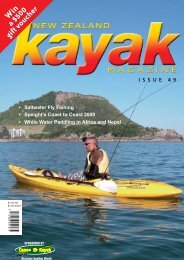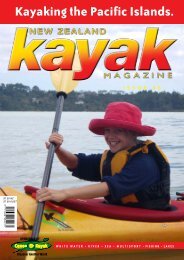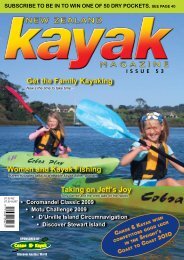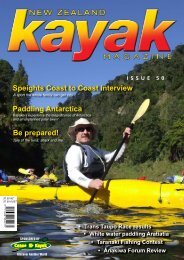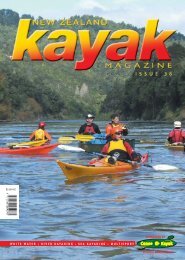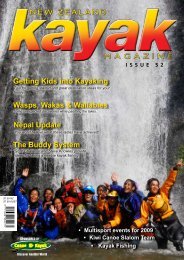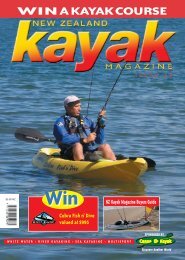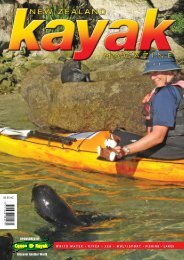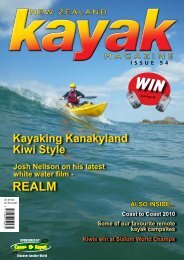HISTORYDacre Cottage, Okura and theman who gave it his nameby Ruth E. HendersonWe were pounding the pavement,building up the legs and miles inpreparation for walking the LakeWaikaremoana track, when I asked mymate Tessa Marshall if she knew of anylocal bush walks I could do.“You can always go and visit my Great GreatGrandfather” she said.That was my first introduction to one of ourcountry’s more colourful characters, CaptainRanulph Dacre - sea-captain, adventurer, pioneerof the timber export trade and the cottage thatbears his name.To get there we parked at Haighs Road, off EastCoast Road, 18 km north of Auckland andfollowed the track along the Okura river estuarythrough groves of nikau, pohutukawa andregenerating kauri to Karepiro Bay.It took us about an hour and a quarter of steadybut gentle plodding.<strong>Kayak</strong>ers can launch at any of the East Coastbeaches: Mairangi Bay, Browns Bay with Long Baybeing the most obvious choice if wanting only ashort paddle of less than 5 km.By water, once across the estuary, it is easy to spota big red barn. Next to it at the northern end ofthe beach lies Dacre Cottage. The cottage wasbuilt around 1855 - 1856 as a farm house for the3,334 acre cattle farm owned by Capt. RanulphDacre and farmed by his sons Henry and LiefSeptimus. Apparently it was built using localbricks and shingles, with the floor being madefrom terra cotta tiles which arrived in one of theCaptains ships as ballast.In the early 1980’s the cottage was in danger ofcollapse and had been vandalized. The HistoricPlaces Trust stepped in and rebuilt the entirecottage using old photos to guide them in itsrestoration. New bricks which matched the oldwere used with the remaining originals reused inthe chimney.When Tessa and I turned up in 2004, much to ourdisappointment the cottage was locked, thewindow shutters nailed up, the garden and fruittrees covered in lichen and surrounding grasstotally over-grown.A shamefully neglected and forlorn remnant ofNZ history - hardly the tribute deserved by oneof the most enterprising early traders of the NZcoasts, who had the sort of adventures that makeyour hair stand on end.Born in 1797 Captain Dacre came from a goodHampshire family, son of Colonel Dacre, HighSheriff of the county. In 1810 at the age of thirteenhe joined the Navy as a midshipman and servedin the 1812 war against the USA. In 1816 heresigned his commission and became captain ofa schooner trading in the West Indies, Australiaand Pacific Islands. Between 1825 and 1831 hetraded between Australia, NZ and London, andthen he married Margaret Sea and settled inSydney. In 1834 in partnership with William Wilkshe set up a mercantile and shipping agency,intending to exploit Pacific products such aswhale oil, sandalwood, kauri timber, greenstoneand flax.Apart from recording that Dacre’s venture into thegreenstone trade was not a success, the historybooks make little mention of these exploits, theexception being the timber trade.Kauri spars and masts were paid for by the linealfoot and according to the diameter. Whereassticks of 3" (75mm) diameter were worth 7 1/2pence per foot (300mm) the larger ones of 30"(750mm) diameter were worth eight shillings andseven pence per foot. Masts of 60 - 70 feet (18 -20m) were needed by the Navy and a good topmast was said to fetch 200 pounds in London. Ican’t imagine what their comparative value wouldbe today! Top dollars!Capt. Dacre took his first load of spars from theHokianga in 1827, trading in the ship Surrey. Whiletrading around the coasts, he visited Mahurangi(and reputably was the first trader in this inlet),Whangaroa, and Mercury Bay.Samuel Marsden had explored the Kaipara’slandward side, but Capt. Dacre in 1832 was thefirst to enter and explore its harbour.The historical material collected by MargaretStevenson and W. Macdonald cites a couple ofadventures: “The Kaipara chief who hadundertaken to assist in procuring the sparssuddenly downed tools and demanded paymentof blankets and tobacco on account. This Dacrerefused to give. Although the chief had a strongfollowing, much larger than the Captains 50 men,Dacre stood up against him, even threatening tothrow him overboard. The Maori was muchimpressed by his audacity and he set aboutearning his payment without more ado.”Another story tells of an awkward and tensemoment when his baby daughter Julia, dangled onthe knee of the chief, Patuone. She seized the greatchief’s topknot. He immediately left the ship with1980Replacing the bricksNearly finishedFinished and beautifulThe old homestead now residing in Whangaparaoa12 ISSUE THIRTYfive • 2006
all his people, the head of the chief being considered sacred and any illtreatmentof it an insult. Retribution seemed imminent. For three days theMaoris debated. Patuone, argued that the child should be treated as ‘porangi’or mad, as the action was not willfully wicked. Luckily this view was adoptedand trading resumed.In another story “in 1832 Dacre travelled from Mahurangi to Coromandel inan open boat to get supplies for his men. On landing, a chief brained one ofhis men. Dacre protested so strongly that the chief confessed his error andoffered one of his slaves to be killed as payment.” Needless to say this offerwas not taken up, but it is obvious that Dacre was a man of courage, quickthinking and able to keep his cool in an emergency.In 1832 Dacre began cutting timber on a large scale. He established a sparstation on the Mahurangi inlet, but H.M.S Buffalo took forcible possession ofthe standing trees. Although Dacre had begun squaring spars and preparingmasts and had had the land surveyed by Mr Florence, he left the stationdeclaring that “I remonstrated with the Admiralty but never got any redress.”He and his associate Gordon Browne resurrected his old station at MercuryBay and in 1837 to facilitate the work they erected a sawmill, driven by waterpower. This mill seems to have been the first timber mill in the country.Dacre’s NZ enterprises were not a financial success, but by 1840 he was aleading merchant in Sydney owning a wharf, ships, and a cattle station. Hewas also appointed a magistrate and was a director of the Union Bank ofAustralia and the Sydney Alliance Assurance Company. In the Depression of1842-1844 he became insolvent and set out to recover debts and propertyrights. This lead him back to NZ and in 1848 he purchased the 3,334 acreWeiti block. In 1854 he entered into partnership with Thomas Macky as amerchant and shipping agent and purchased more land including 4,000 acresat Omaha, still referred to as Dacre’s claim. In 1859 the family moved toAuckland, where he became one if its best-known and respected citizens.T. Macky and Co was one of the largest firms in the city, and towards the endof his life Dacre was once again wealthy. Throughout all the trials of being anearly colonist, his wife of 55years was his constantcompanion. About 1878 they returned to England,where he died in 1884Since, my first visit and subsequent delving intoDacre’s history, the cottage is having another leaseof life. In the winter of 2005 Peter Townenddecided the cottage was worth preserving and ahandy location for Yakity Yak visits.He entered into discussion with the RodneyDistrict Council, owners of the land and building.Several working bees by club members and lotsof on-going lawn mowing and talking by Pete havefollowed. Now we have a good base for club tripsand even overnight stays.Pete tells me “There is a BBQ and cookingequipment, all people need to bring is food andbedding and they can sleep in the cottage (onedouble and one single). We have a couple of siton-kayaksfor use and outdoor tables and chairs.Long drop toilets and paper are supplied.“The cottage may be booked by contactingme on 0274 529255 or on email atpete@canoeandkayak.co.nz “ReferencesRogers, Frank. Dacre, Ranulph 1797 - 1884Dictionary of NZ BiographyStevenson, M & W. Macdonald ‘Captain RanulphDacre’ Auckland - Waikato Historical Journal No 37www.doc.govt.nz/Explorewww.dnzb.govt.nzwww.odnz.co.nzPat Costello helps transforma paddock to a lawn.Rob Howarth eats weeds.Even the gutters get a clean.ISSUE THIRTYfive • 2006 13


